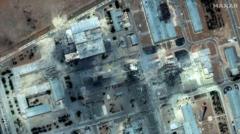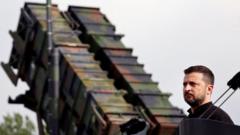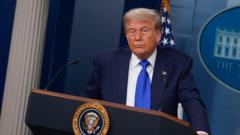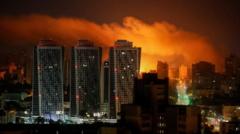Following U.S. military action against Iranian nuclear sites, an Israeli official indicates that enriched uranium at Isfahan remains accessible to Iran, risking further conflict.
Israeli Official Raises Concerns on Iran's Enriched Uranium Post-U.S. Strikes

Israeli Official Raises Concerns on Iran's Enriched Uranium Post-U.S. Strikes
A senior Israeli official warns that Iran may recover enriched uranium from facilities targeted by U.S. strikes, despite claims of total destruction.
Article Text:
In a gripping update regarding the ongoing tensions in the Middle East, a senior Israeli official has revealed to U.S. reporters that Iran might be capable of recovering some of its enriched uranium buried beneath one of the three nuclear facilities struck by U.S. forces on June 22. The official pointed to Isfahan, noting that any attempts by Iran to access the materials would provoke new Israeli airstrikes.
While former President Donald Trump has confidently asserted that the U.S. air and missile strikes drastically "obliterated" Iran's nuclear capabilities, U.S. intelligence reports take a more cautious stance. Iran consistently claims its uranium enrichment efforts serve peaceful purposes rather than military ambitions.
In a confidential briefing, the unnamed Israeli official referenced intelligence suggesting a significant portion of Iran's enriched uranium is located at the Isfahan site, targeted during "Operation Midnight Hammer." Despite this troubling information, the official expressed confidence in Israel’s ability to detect any Iranian attempts to recover the materials, assuming they were not entirely destroyed in the strikes.
The Israeli perspective estimates that Iran’s nuclear program has been delayed by at least two years due to the strikes. White House spokesperson Anna Kelly reinforced Trump's previous assertions regarding the obliteration of Iranian nuclear assets, asserting that global safety has improved due to decisive U.S. actions.
Nevertheless, U.S. intelligence reports contradict this narrative, revealing in a leaked Defense Intelligence Agency document that while significant damage was inflicted on the three sites—Fordo, Natanz, and Isfahan—none were completely eliminated. CIA Director John Ratcliffe previously informed lawmakers that the destruction of Iran's metallic uranium production facility significantly hampered Iran's nuclear weapon capabilities.
In a statement to CBS, Rafael Grossi, head of the International Atomic Energy Agency (IAEA), echoed the sentiments of the cautious U.S. assessments, acknowledging considerable destruction yet asserting that parts of the sites remain intact. Iranian President Mahmoud Pezeshkian admitted in a recent interview that the facilities sustained severe damage, rendering access nearly impossible and hindering any comprehensive evaluation of their status.
The situation remains precarious, highlighting the unpredictability of threats from Iran and the continued escalation of tension in the region.
In a gripping update regarding the ongoing tensions in the Middle East, a senior Israeli official has revealed to U.S. reporters that Iran might be capable of recovering some of its enriched uranium buried beneath one of the three nuclear facilities struck by U.S. forces on June 22. The official pointed to Isfahan, noting that any attempts by Iran to access the materials would provoke new Israeli airstrikes.
While former President Donald Trump has confidently asserted that the U.S. air and missile strikes drastically "obliterated" Iran's nuclear capabilities, U.S. intelligence reports take a more cautious stance. Iran consistently claims its uranium enrichment efforts serve peaceful purposes rather than military ambitions.
In a confidential briefing, the unnamed Israeli official referenced intelligence suggesting a significant portion of Iran's enriched uranium is located at the Isfahan site, targeted during "Operation Midnight Hammer." Despite this troubling information, the official expressed confidence in Israel’s ability to detect any Iranian attempts to recover the materials, assuming they were not entirely destroyed in the strikes.
The Israeli perspective estimates that Iran’s nuclear program has been delayed by at least two years due to the strikes. White House spokesperson Anna Kelly reinforced Trump's previous assertions regarding the obliteration of Iranian nuclear assets, asserting that global safety has improved due to decisive U.S. actions.
Nevertheless, U.S. intelligence reports contradict this narrative, revealing in a leaked Defense Intelligence Agency document that while significant damage was inflicted on the three sites—Fordo, Natanz, and Isfahan—none were completely eliminated. CIA Director John Ratcliffe previously informed lawmakers that the destruction of Iran's metallic uranium production facility significantly hampered Iran's nuclear weapon capabilities.
In a statement to CBS, Rafael Grossi, head of the International Atomic Energy Agency (IAEA), echoed the sentiments of the cautious U.S. assessments, acknowledging considerable destruction yet asserting that parts of the sites remain intact. Iranian President Mahmoud Pezeshkian admitted in a recent interview that the facilities sustained severe damage, rendering access nearly impossible and hindering any comprehensive evaluation of their status.
The situation remains precarious, highlighting the unpredictability of threats from Iran and the continued escalation of tension in the region.





















